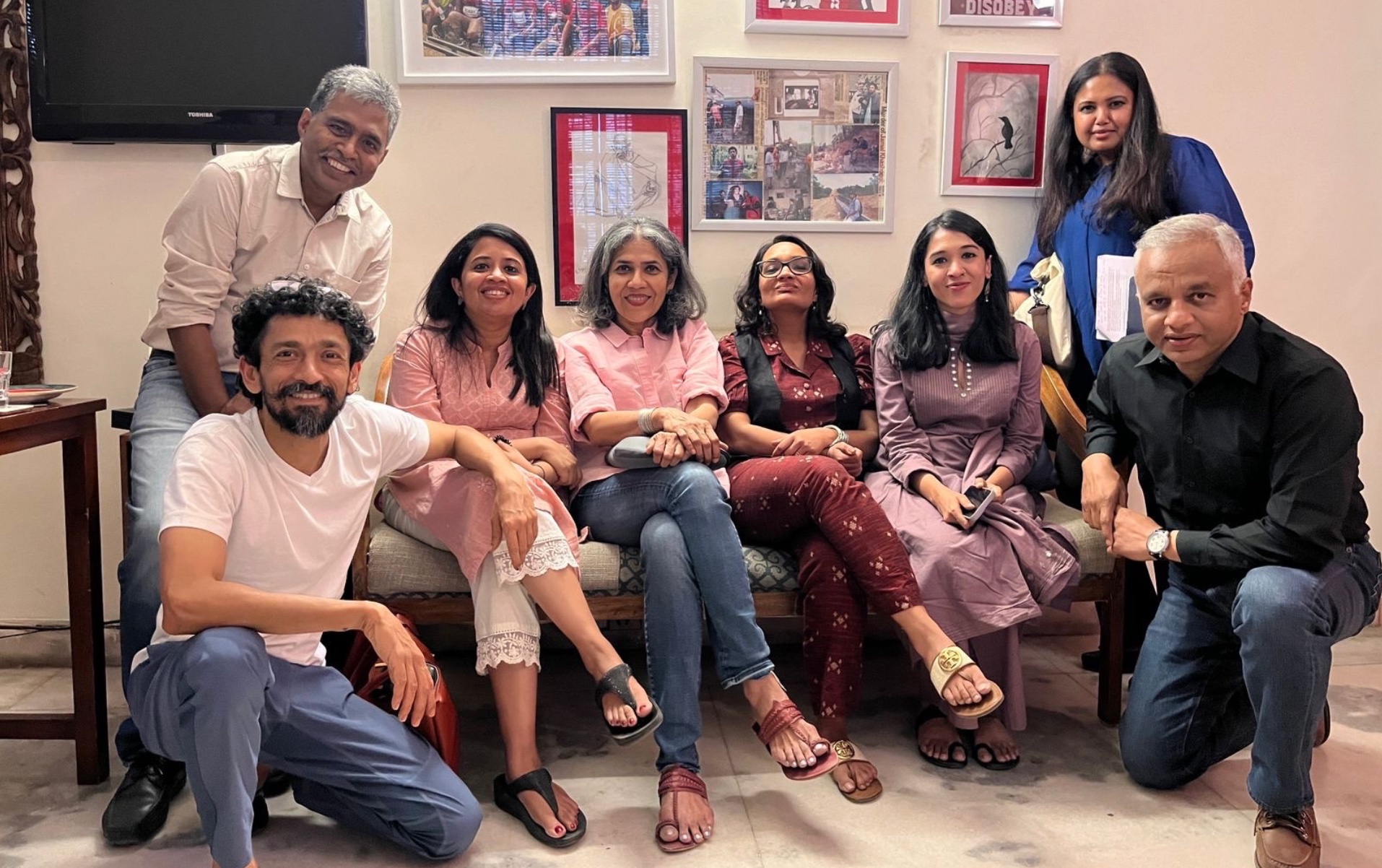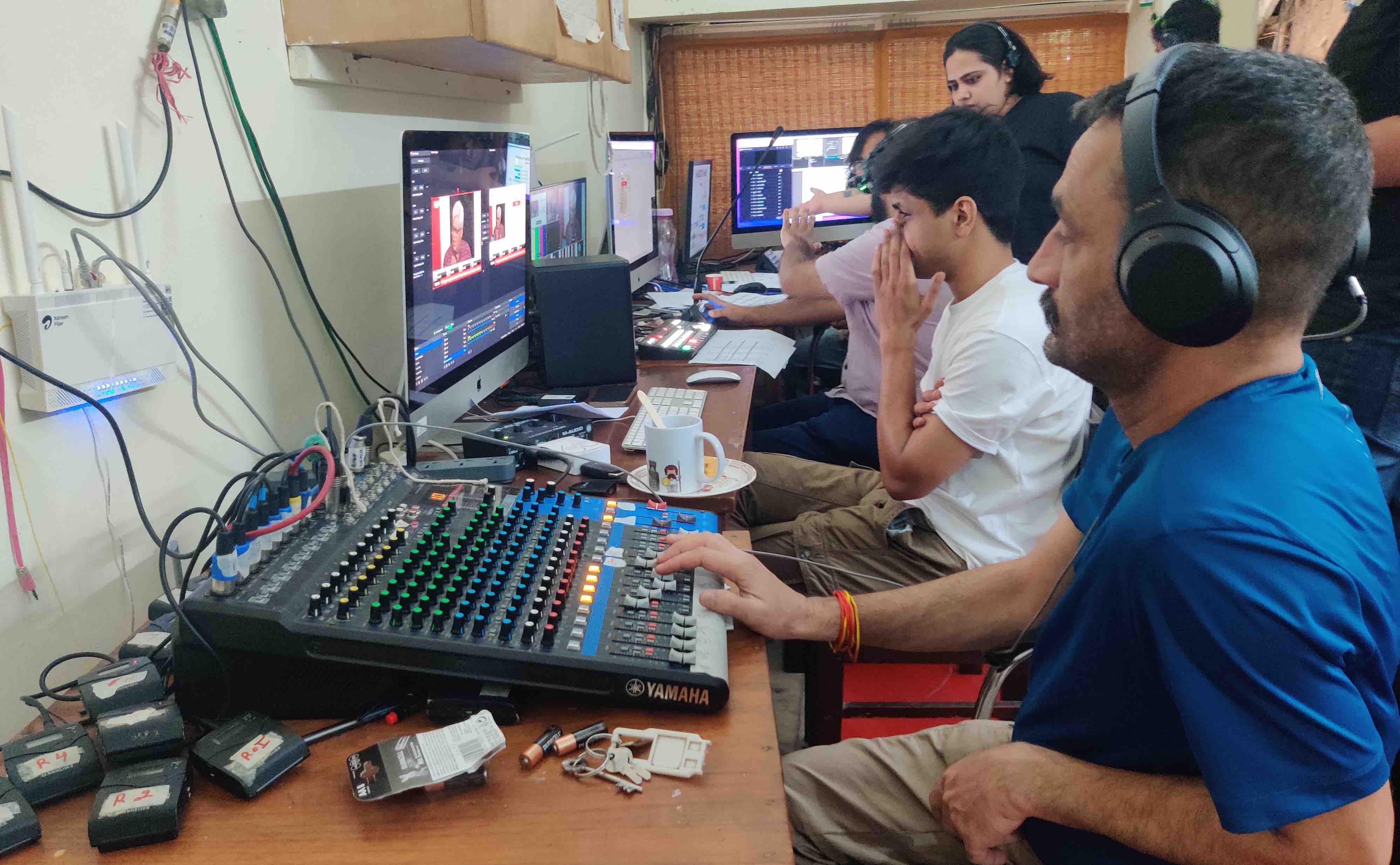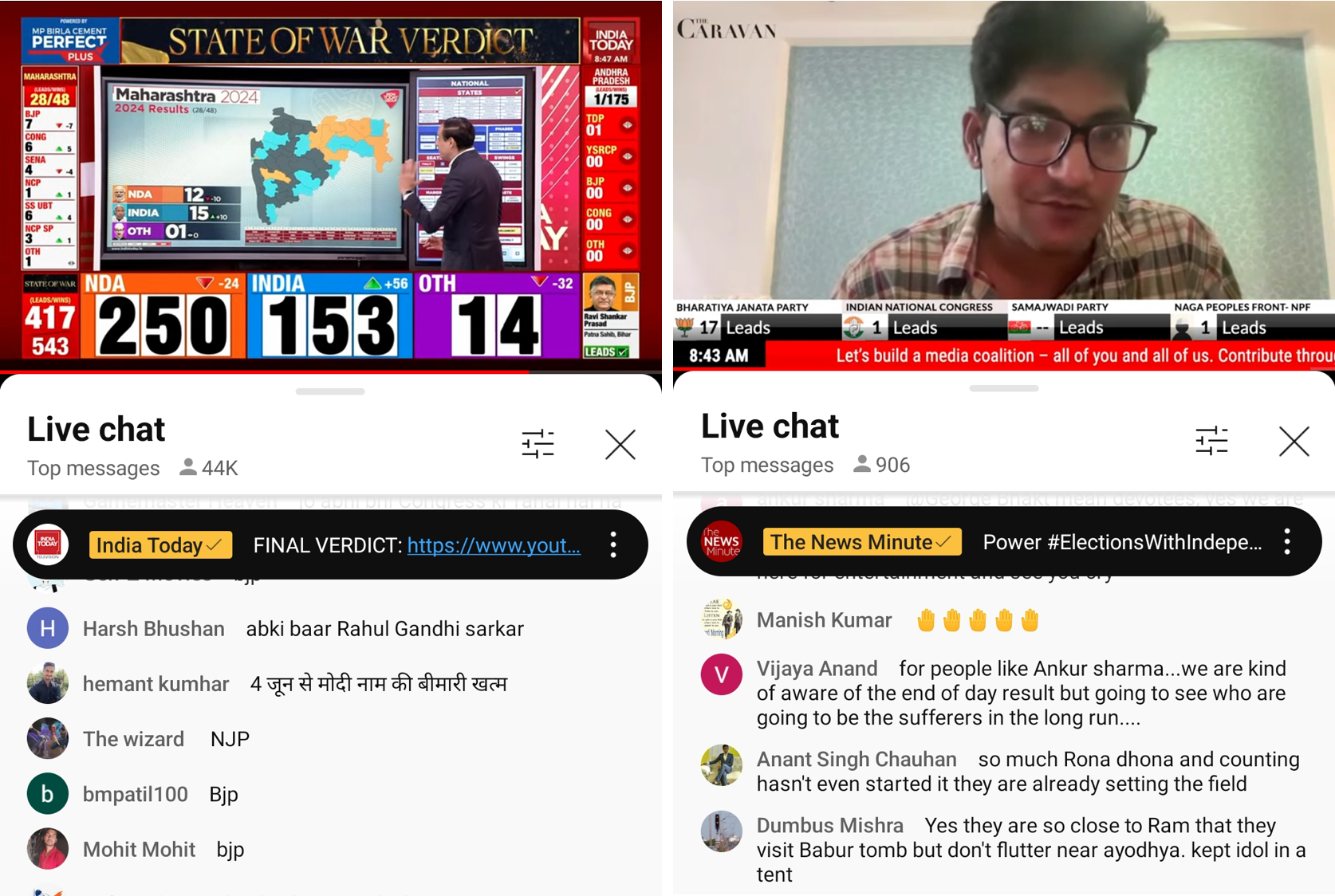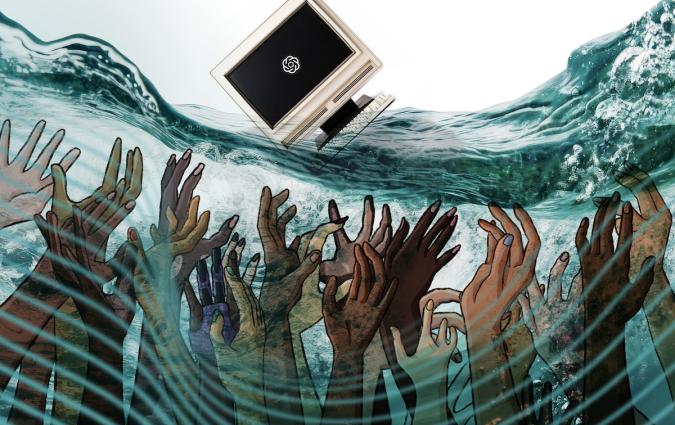How five news outlets joined forces to broadcast the Indian elections' result with the help of audience funding

The teams of Newslaundry, The News Minute, The Wire, The Caravan and Scroll at the day of the elections results. | Credit: Abhinandan Sekhri's X account.
At 7:30 on 4 June, a regular bungalow in South Delhi was swarming with young journalists striding around with their laptops surrounded by cups of coffee and tea.
The basement of the house was transformed into a studio, with cameras pointed at five guests and a small adjoining room as a make-shift control room. A diesel generator stood outside the house to provide electricity backup, in case of a power outage.
The bungalow was the centre of an innovative initiative. For the first time, five independent news organisations came together to interpret the results of the Indian election, where 640 million people cast their vote over six weeks, was simulcast live on the YouTube channels of Newslaundry, The News Minute, The Wire, The Caravan and Scroll.
On the first floor of the bungalow, about 10 journalists crowded on two small glass tables and were tasked with tabulating the data that trickled in from the Election Commission of India. There were separate teams for social media management, guest coordination and research.
Over seven and a half hours, senior journalists and editors contextualised the story of how Narendra Modi’s political party did not garner enough seats to secure a majority and what a new coalition might mean for India. At the top of every hour, the moderators of the panel would remind their audiences that the YouTube broadcast was made possible by their donations, and not by government or corporate funding.

Collaboration vs competition
In April 2023, Delhi-based independent news company Newslaundry and Bangalore-based The News Minute formed an alliance to work together and declared this to be the age of collaboration in journalism. A few weeks later, three other digital-first organisations – Scroll, The Wire and The Caravan – joined them in interpreting state-level election results, which was simulcast on all of their YouTube channels.
It was easy for the organisations to join hands, said Abhinandan Sekhri, co-founder and CEO of Newslaundry, while he encouraged the team to regularly break for eating and hydrating themselves. “Elections are a high-octane game,” he said. “They often suck us in and we forget to do mundane but important things like eating.”
The founders and senior editors of the five organisations have decades of media experience and crossed paths at different points in their careers, explained Sekhri. “If anything, we are surprised we did not collaborate earlier,” he said.
All five organisations have different newsroom structures, funding models and content output.
Newslaundry received its seed funding from the nonprofit Omidiyar Network India, but they now rely on a subscriber-funded model. The Caravan is published by the Delhi Press Group, which runs 33 general interest magazines in 10 different languages. The News Minute combines a subscriber model with advertising, but also has other investors. Scroll has institutional investors and encourages membership. The Wire is backed by a nonprofit called the Foundation for Independent Journalism.
“What brought us together is our combined understanding that news is not a commodity but a public service,” said Seema Chishti, an editor at The Wire. “We all believe journalism thrives in collaboration, not in competition.”
Supriya Sharma, Executive Editor of Scroll, said the collaboration was the result of the way the news media has developed in India in the past decade.
Since Modi took power in 2014, India slipped eleven places in the press freedom index to 161, below Pakistan and Afghanistan. Funding for independent media dried up, journalists were targeted for their work and laws restricting press freedom were passed. In the midst of such restrictions, the common goal for all five organisations is practising “watchdog journalism,” Sharma said.
Asking tough questions has put these five organisations in the line of fire. “We have heard of their journalists being attacked or put behind bars,” said Ritika Pant, a senior media educator. “This collaboration really provides the independent media organisations some security in numbers.”
No one was apprehensive about the coming together, Sekhri said, because none of them have saturated the market by themselves: “No one is seeking to eat into another’s share.”
Still small in comparison
None of the five organisations have the heft of a mainstream media organisation and they need many more pairs of hands to do sophisticated graphics, number crunching and have wider reach, said Kishalay Bhattacharjee, Dean of the Jindal School of Journalism and Communication.
This was evident on election results day. At 8:47, when most people tuned in to follow the results, the number of viewers on the simulcast fluctuated around one thousand viewers, while the YouTube live of a mainstream channel like India Today English was more than 44,000. In comparison, a Hindi channel like AajTak of the India Today network had more than 870,000 views around the same time.

For office goers like Gurgaon-based Rahul Pandey, watching a mainstream TV channel on their laptops was more convenient. “I was at work all day but was extremely curious about the election results,” he said. So he watched the TV channels on mute. The graphics and data that was flashing on the screens gave him all the information he needed.
Moreover, the simulcast updated the numbers from the Election Commission website. “You can see it as a weakness that we do not have real time data,” admitted Sharma from Scroll. Most television channels displayed data in advance of the Election Commission because they used paid services by specialised agencies for the advance information. “Since we do not have the financial power to buy such data, our figures might have looked comparatively stale,” she said.
The comeback of a veteran
This time around, there was another factor which put a dent in the viewership of the simulcast.
A veteran of elections coverage in India, Prannoy Roy, launched his new news website called DeKoder. Roy, who was the founder of NDTV, is known for introducing polling experts to Indian television viewers decades ago. His presence was a constant during elections.
In March 2023, the Adani group, which is considered to be close to Prime Minister Modi, took over Roy’s NDTV and many viewers have missed Roy ever since. The comments under the 11-hour YouTube DeKoder broadcast suggest that many Indians missed watching Roy during elections. “I always used to tune into NDTV whenever it’s the election day since my school days,” said one comment. “I wasted watching those stupid news channels instead of this. Pranab Roy is the GOAT!” said another, using the acronym for “Greatest Of All Time”.
In addition, DeKoder’s screen was full of up-to-date election data. Between 8:00 and 9:00, DeKoder had about 13,000 viewers, which was about three times that of the simulcast. The numbers only increased from there. “DeKoder is old school magic brought back to life,” said Bhattacharjee from the Jindal School of Journalism, who was also a senior reporter for NDTV for many years.
Many journalists from the five independent media organisations like Supriya Sharma and Abhinandan Sekhri have also worked at NDTV for many years. The Wire’s Chishti said they were aware of DeKoder’s broadcast. “We did discuss it but were not bothered by it,” she said.
Despite the fact that the five organisations have collaborated on broadcasting state election results last year, Chishti said, they were still young and new compared to some of DeKoder’s broadcasters who have years of experience in NDTV.
How they were different
The screen of the simulcast was starkly different from the programmes of other news organisations. The anchors repeatedly reminded their viewers that they were ad-free, whereas every single inch of the screen space was used up on mainstream TV channels.
Television channels and DeKoder brought in various pundits to the studio to unpack the results and what it means for the average Indian. But the simulcast regularly spoke to their reporters who had gone to remote corners of the country to cover the elections.
“I have not seen the TV news for a long time. It is very loud,” said Mumbai-based Urdu tutor Akshita Nagpal. “I am better informed [by the simulcast], along with other platforms also including DeKoder and Maktoob Media.”
Newslaundry and The News Minute raised about $48,000 from subscribers for this exercise of joint election reporting, and this included rigorous ground reports from far corners of the country.
The five organisations spent the months leading up to the elections doing what New York University professor Jay Rosen calls “audience-centric reporting”, listening to people and trying to find answers to the questions they most cared about.
During the panel discussion editors referred to the work done by their reporters and by reporters from other four organisations. Three of these organisations – Scroll, The News Minute and Newslaundry – came together for a pre-election collaborative project in April.
A unique form of political funding called electoral bonds was introduced in 2017. These bonds were anonymous paper instruments that anyone could buy from the State Bank of India and give to a political party, which could redeem them for money. The Supreme Court declared the bonds illegal in February saying they increase the secrecy in political funding and ordered the State Bank to put all the funding data in the public domain.
“Instead of all of us mining through the data, we collaborated,” said Sharma. About three dozen stories came from this work.
The YouTube elections?
TV channels and digital-only platforms such as DeKoder were not the only competition to the simulcast of these five news organisations. Lone wolf YouTube newscasters were also vying for a share of the pie.
Veteran anchor and journalist Ravish Kumar did not broadcast the election results live, but by noon, once the results were almost certain, he went live on YouTube for less than half hour to give his analysis of the election results until then. He garnered more views than all the others had since morning. By 12:20, he had more than 2 million people viewing his channel.
In every email we send you'll find original reporting, evidence-based insights, online seminars and readings curated from 100s of sources - all in 5 minutes.
- Twice a week
- More than 20,000 people receive it
- Unsubscribe any time
signup block
In every email we send you'll find original reporting, evidence-based insights, online seminars and readings curated from 100s of sources - all in 5 minutes.
- Twice a week
- More than 20,000 people receive it
- Unsubscribe any time







